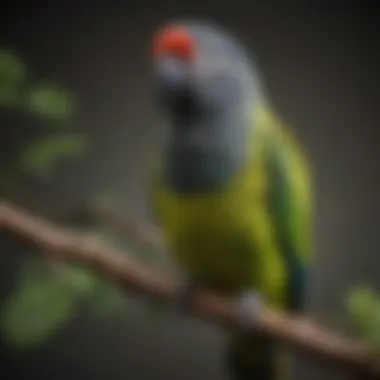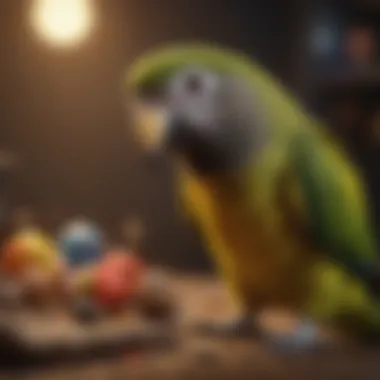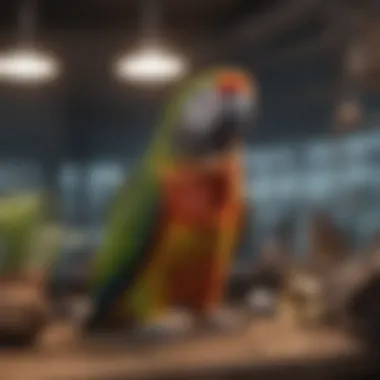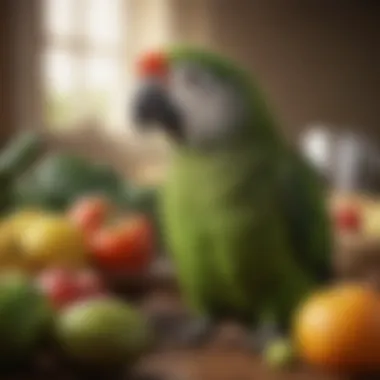Understanding the Meyers Parrot: An In-Depth Guide


Intro
Meyers Parrots are often overlooked in the realm of pet birds. This species offers a unique blend of personality and charm. Understanding their characteristics is essential for any pet owner. By diving into their needs and traits, prospective owners can provide a nurturing environment. This guide aims to illuminate the fascinating world of Meyers Parrots and ensure a rewarding bond between humans and birds.
Understanding Your Pet
Pet Behavior Basics
Meyers Parrots have a distinct behavioral profile. They are known for their playful and gentle nature. These birds thrive on social interaction. They can develop strong bonds with their owners, leading to affectionate relationships.
Socialization is crucial. Early exposure to diverse environments, sounds, and people can positively influence their behavior. They may exhibit reserved traits around strangers but often warm up with time.
Common Breed Characteristics
The Meyers Parrot is often characterized by its small, stout body and vivid plumage. Typically, these birds have a dark green body with splashes of yellow and orange on their underwings. Their beaks are short but strong, reflecting their all-seed diet in the wild.
Their vocalizations are generally soft. They can mimic sounds and words, though they do not have the same capacity as larger parrots. Their social nature makes them expressive through a combination of sounds and body language.
Species-Specific Needs
Meyers Parrots require specific care to thrive. They need ample mental stimulation and physical exercise. Proper socialization, a varied diet, and safe spaces for play are essentials. Ensuring their environment mimics their natural habitat helps them feel secure and happy.
Pet Care and Maintenance
Feeding Guidelines
A balanced diet is vital. This includes fresh fruits, vegetables, and high-quality pellets. Seeds can be part of the diet but should not be the primary source of nutrition. Offering a variety of foods keeps them engaged and healthy.
Avoid avocado, chocolate, and caffeine as they are toxic to birds. Fresh water should be available at all times, and bowls must be cleaned regularly.
Grooming Essentials
Grooming is important for a Meyers Parrot. Regular nail clipping is essential to prevent overgrowth. Bathing should occur weekly or as needed to maintain feather health. Some birds enjoy in-bath water, while others prefer misting.
Hygiene Practices
Maintaining hygiene is crucial for their well-being. Cleaning the cage, toys, and food dishes regularly helps prevent disease. Daily checks ensure that their living environment remains safe and comfortable.
Training and Development
Basic Commands and Skills
Training Meyers Parrots can be rewarding. Start with basic commands like
Meyers Parrot Overview
The Meyers Parrot, a small yet remarkable bird, has captured the fascination of avian enthusiasts and pet owners alike. This section outlines the significance of understanding the Meyers Parrot, highlighting various elements such as its species origin, physical characteristics, and behavioral traits. Knowledge of these factors not only contributes to a deeper appreciation of the species but also aids in providing proper care and ensuring a satisfying companionship with these intelligent creatures.
Species Origin
The Meyers Parrot, Poicephalus meyeri, originates from the central and western regions of Africa. Its natural habitat includes woodlands, savannahs, and open forests where it thrives in social flocks. The understanding of its origin is crucial for potential owners as it explains the bird's social nature and behavioral patterns. Living in a flock in the wild shapes many of its interactions and needs in captivity.
Physical Characteristics
Size
The Meyers Parrot averages about 8 to 10 inches in length. This modest size makes it a suitable bird for various living situations, especially in smaller homes or apartments. Its compact body allows it to be relatively easy to manage while also providing enough presence to be visually engaging as a pet. The size affects the space and resources needed, making it manageable for potential pet owners.
Coloration
In terms of coloration, the Meyers Parrot exhibits a delightful range of greens, complemented by hints of yellow and blue, particularly visible on its wings. This vibrant plumage not only enhances its appearance but also reflects its adaptability to its environment. The layers of colors can be an attractive feature for bird lovers seeking a visually appealing pet, offering a spectrum of hues that can brighten any space.
Distinctive Features
Distinctively, Meyers Parrots possess a rounded head and a sturdy beak well-suited for cracking seeds and nuts. Their short tails and robust build give them a charmingly compact silhouette, adding to their appeal as companion birds. These physical characteristics play a significant role in their behavior and care needs, influencing everything from cage setup to handling.


Behavioral Traits
Social Nature
Meyers Parrots are inherently social creatures. They thrive on interaction, whether with other birds or their human companions. Understanding their social nature emphasizes the importance of regular engagement and bonding time with their owners, vital for their happiness and well-being. Owning a Meyers Parrot requires a commitment to socialization, which can enrich both the bird's and owner's life.
Vocalization
When it comes to vocalization, Meyers Parrots can produce a variety of sounds, including whistles and chirps, although they are not known for being overly noisy. This aspect can be ideal for those wanting a bird that won’t disrupt the household. However, it is important to note that each parrot has an individual personality, impacting their vocal tendencies.
Intelligence
The intelligence of Meyers Parrots is noteworthy. They can learn tricks and phrases, showcasing their capability for training and interaction. This intelligence level makes them engaging companions but also requires stimulated environments. Pet owners must be prepared to challenge their birds mentally to prevent boredom, which could lead to behavioral issues.
Understanding the unique blend of social nature, intelligence, and vocalization traits helps prospective owners assess their readiness to provide the necessary engagement for a Meyers Parrot.
This overview of the Meyers Parrot offers insight into the essence of this captivating species, laying the groundwork for responsible ownership and creating a nurturing environment.
Choosing a Meyers Parrot
Choosing a Meyers Parrot is a significant decision for any potential pet owner. This bird's charm and unique characteristics make it a desirable companion. However, various factors should be taken into account before making this commitment. Understanding where to find a Meyers Parrot and the implications of selecting a bird of a certain age can greatly impact the owner's experience.
Availability and Sources
When considering a Meyers Parrot, the first step is knowing where to find one. Reputable breeders are the most reliable source for acquiring a healthy and well-socialized bird. A reliable breeder will not only provide a healthy parrot but also insights into its lineage and temperament. It is advisable to visit the breeding facility if possible, as this allows potential buyers to evaluate the living conditions.
In addition to breeders, pet stores may offer Meyers Parrots. However, it is crucial to ensure these stores follow responsible breeding practices. Online platforms can also connect enthusiasts to breeders or rescues. Organizations such as the American Society for the Prevention of Cruelty to Animals often have birds available for adoption. Adopting from a rescue can be a fulfilling way to provide a home for a parrot in need.
Regardless of the source, it is essential to verify the health of the bird before bringing it home. This includes checking for signs of illness and asking for medical records if available. Ensuring the bird is not only healthy but also acclimated to human interaction will better translate into a harmonious home environment.
Age Considerations
Age is a crucial factor when choosing a Meyers Parrot. Young birds, typically under six months, are often more adaptable and easier to train. They tend to bond quickly with their new owners, which is advantageous for socialization. Hand-fed chicks usually develop stronger connections with humans, making them great companions for families.
Conversely, older Meyers Parrots may come with a set of established behaviors and quirks. They might require more time to adjust to a new environment. However, they can also offer the advantage of being already trained. Potential owners should be prepared for the possibility of behavioral challenges with older birds. Moreover, the history of the bird should be thoroughly discussed with the previous owner or shelter.
In summary, whether choosing a young or older bird, understanding the implications of age is essential. Each stage comes with its own advantages and challenges, and prospective owners should reflect on their lifestyle and capability to meet the needs of the parrot they choose.
Housing Needs
Housing for a Meyers Parrot is not just a matter of aesthetics; it plays a crucial role in their overall well-being and health. Providing an appropriate and stimulating living environment directly impacts the physical and mental condition of these birds. Attention to details such as cage size, materials, and placement can significantly enhance the quality of life for a Meyers Parrot.
Cage Requirements
Size
When it comes to the size of the cage, larger is always better. A spacious cage allows the bird to move freely, stretch its wings, and engage in natural behaviors. This enhanced mobility is key, as limited space can lead to stress and behavioral issues. Ideally, a cage should be at least 24 inches wide, 24 inches deep, and 36 inches high. A larger cage encourages climbing and exploring, which Meyers Parrots enjoy doing.
Materials
The materials used for the cage are also important. A sturdy metal cage is preferred over wooden or plastic ones. This is not only due to durability but also because they are easier to clean. Stainless steel or powder-coated metal provides safety and prevents harmful substances from leaching into the environment. It is crucial to ensure that the bars are close enough together to prevent the bird from escaping or getting caught.
Placement
The placement of the cage can affect the bird's social interaction and comfort. The cage should be placed in a well-lit area but not in direct sunlight, as extreme temperatures can cause stress. Additionally, it should be positioned where the family spends most time, allowing the parrot to engage with its environment and feel part of the family dynamics. However, avoid high-traffic areas where the bird may feel insecure or scared.
Environmental Enrichment
Toys
Toys are vital for keeping a Meyers Parrot stimulated. They provide mental engagement and reduce boredom, which can lead to negative behaviors such as feather plucking. Rotate toys regularly to maintain interest and challenge the bird. Look for toys made from safe materials that encourage foraging behavior, helping keep the bird's mind active.
Climbing Options
Meyers Parrots are natural climbers. Providing adequate climbing options within and outside of the cage can help strengthen their muscles and provide exercise. Branches from non-toxic trees or specially designed climbing structures can be beneficial. They satisfy the birds' instinct to explore vertically, promoting healthy behaviors and reducing stress.
Interaction


Interaction with humans and other pets is essential for social birds like the Meyers Parrot. Regular one-on-one time helps them develop trust and strengthens their bond with their owners. Engaging them in activities such as training sessions or simply spending time nearby can enrich their lives. However, be mindful of their mood and stress levels; always approach interactions positively.
Remember: Creating a well-structured environment is pivotal for the Meyers Parrot's happiness and health. A proper cage, stimulating toys, climbing options, and regular interaction are key components in fostering a nurturing habitat.
Dietary Needs
The dietary needs of the Meyers Parrot play a fundamental role in its overall health and well-being. A balanced diet is essential not just for physical health, but also for optimal behavior and longevity. Misunderstanding or neglecting these needs can lead to significant health issues and behavioral problems. This section explores the basic nutritional requirements and the appropriate treats and supplements for these birds.
Basic Nutritional Requirements
Meyers Parrots require a varied diet to thrive. Their diet should primarily consist of high-quality pellets specifically designed for parrots. These pellets can provide balanced nutrition, including the necessary vitamins and minerals. In addition to pellets, fresh fruits and vegetables are important. Some good choices include:
- Leafy greens like kale and spinach
- Fruits such as apples, bananas, and berries
- Vegetables like bell peppers and carrots
It's crucial to avoid avocados and chocolate, as they are toxic to parrots. Fresh foods should be washed thoroughly and provided in small, manageable pieces to encourage feeding. Regular offering of these foods not only enriches their diet but also stimulates their natural foraging behavior.
Additionally, incorporating small amounts of seeds can be beneficial. However, these should only be a minor part of the diet due to their high fat content. Offering a variety of foods can keep the Meyers Parrot engaged and healthy.
Treats and Supplements
Treats can be an effective way to bond with your Meyers Parrot and reward good behavior. Healthy treats include unsalted nut pieces, bits of whole grain bread, and small pieces of dried fruit. It is important to limit the quantity of treats to prevent weight gain.
Supplements are generally not necessary if a balanced diet is maintained. However, in certain situations, they can provide extra nutrients. For instance, if a bird is ill or has specific dietary deficiencies, a veterinarian might suggest additional vitamins or minerals. Calcium is particularly important for breeding pairs or older birds.
The right balance of nutrients is critical for the health of the Meyers Parrot. A poor diet can lead to serious health issues.
In summary, understanding the dietary needs of the Meyers Parrot ensures that they remain happy and healthy. Proper feeding practices not only support their physical health but also contribute to their overall behavior and quality of life.
Health Care
Health care is a critical aspect of owning a Meyers Parrot. Like any pet, these birds require regular medical attention to ensure their overall well-being. Maintaining good health is essential for their longevity and happiness. By understanding common health issues and establishing a routine for veterinary care, owners can prevent many problems from arising.
Common Health Issues
Meyers Parrots may be susceptible to a range of health concerns. Some common health issues include:
- Obesity: Due to their relatively sedentary nature when kept in captivity, these parrots can easily gain weight. Overfeeding and lack of exercise contribute significantly to this issue.
- Feather Plucking: This behavioral issue can stem from stress or boredom. It may often lead to skin problems and other complications.
- Respiratory Problems: Meyers Parrots have delicate respiratory systems. Exposure to smoke, dust, or poor air quality can lead to infections and other respiratory issues.
Identifying these issues early can make a significant difference in the treatment and recovery process.
Veterinary Care
Veterinary care includes two main components: routine check-ups and vaccination needs.
Routine Check-ups
Routine check-ups are vital for monitoring a Meyers Parrot's health. These visits allow for early detection of any potential issues. Many owners find them beneficial because they offer peace of mind about their pet's health.
During a routine check-up, the avian veterinarian will typically:
- Assess the bird's weight and physical condition.
- Check for signs of illness or distress.
- Provide advice on diet and exercise.
This process ensures that any health concerns are addressed promptly. It is crucial, as early intervention can lead to better outcomes. The unique feature of routine check-ups is their preventative nature. They help catch issues before they become severe, which is a clear advantage in bird care.
Vaccination Needs
Vaccination needs are another important element of avian health care. While not all vaccines are necessary for Meyers Parrots, some vaccinations can protect against common diseases.
Key vaccinations include:
- Polyomavirus: This is crucial in young birds and can prevent serious health threats.
- West Nile Virus: Immunization against this virus is recommended in areas where it is prevalent.
Understanding the vaccination schedule and adhering to it is beneficial for ensuring the long-term health of your pet. The unique aspect of vaccinations lies in their role as prevention tools. They protect against diseases that could otherwise be critical.
Maintaining the health of your Meyers Parrot requires understanding and a commitment to proper care. Regular veterinary visits and preventive measures can lead to a happy, healthy bird.
By prioritizing health care, owners can contribute to a better quality of life for their Meyers Parrots, enhancing their experience both for the owners and their beloved pets.


Training and Socialization
Training and socialization of the Meyers Parrot are crucial for its overall well-being and happiness. This unique bird thrives not just on physical care but also on mental stimulation. Adequate training ensures that the parrot develops good habits and manners, which are essential in a home environment. Moreover, socialization encourages the bird to build healthy relationships with both humans and other pets, creating a more harmonious domestic atmosphere.
It is important to understand that the Meyers Parrot is an intelligent species. This intelligence requires proper engagement to keep them from becoming bored or anxious. A well-trained parrot will exhibit less behavior problems, making it more enjoyable for the owner and the bird itself. Furthermore, consistent training can help prevent potential challenges, such as biting or excessive screeching.
Basic Training Techniques
When it comes to training a Meyers Parrot, there are several effective techniques that pet owners can employ. Here are some basic methods:
- Positive Reinforcement: This method involves rewarding desirable behaviors with treats, praise, or affection. It is not only effective but also strengthens the bond between the bird and owner.
- Consistency: Establishing a routine can help your parrot learn commands and tricks. Use the same words and phrases consistently to prevent confusion.
- Short Sessions: Keep training sessions brief, lasting around 5 to 10 minutes. This structure prevents fatigue and maintains the bird’s interest.
- Patience: Every bird learns at its own pace. Be patient and understanding during the training process.
- Target Training: Use a stick or finger as a target, encouraging the parrot to touch it with its beak. This can be a stepping stone to more complex tricks.
Employing these techniques can aid in developing a well-adjusted and well-mannered Meyers Parrot.
Importance of Socialization
Socialization is equally as critical as training for a Meyers Parrot. This process exposes the bird to different people, environments, and other animals. Here are some key points regarding the importance of socialization:
- Reducing Fear: Early socialization can minimize fear and anxiety in various situations. By exposing the parrot to diverse experiences, it becomes more adaptable and less prone to stress.
- Building Confidence: Frequent interaction boosts confidence levels, allowing the bird to explore its surroundings more freely.
- Encouraging Healthy Interactions: By socializing with other pets and people, your parrot learns appropriate behavior, reducing the risk of aggression.
- Strengthening Bonds: Engaging with the bird fosters a stronger emotional connection, ultimately benefiting both the parrot and the owner.
Socialized birds are happier birds. A lifetime of companionship requires proper social understanding.
Potential Challenges
Understanding the potential challenges of owning a Meyers Parrot is essential for both current and future pet owners. This section will delve into the various behavioral issues and the time investment required to ensure that these birds thrive in a domestic setting. Approaching these challenges thoughtfully can lead to a nurturing environment that benefits both the owner and the parrot.
Behavioral Issues
Bitiness
Bitiness is a common behavioral issue experienced with Meyers Parrots. It typically occurs when the bird feels threatened or stressed. This reaction can be particularly alarming for pet owners who may be unprepared for such behavior. Understanding the roots of bitiness is key to fostering a positive relationship.
The key characteristic of bitiness is its emotional basis. These birds require a sense of safety and security to feel comfortable. When this need isn't met, they may resort to biting as a form of communication or defense. While it can be disconcerting, addressing this issue appropriately can transform the situation. Owners who spend quality time with their birds frequently and engage in positive reinforcement training often see improvements over time.
A unique feature of dealing with bitiness lies in the training process. Establishing trust through gradual interaction helps mitigate this issue. The advantage of overcoming bitiness is the strengthened bond it creates between the pet and owner.
Noisy Behavior
Another significant behavioral issue is noisy behavior. Meyers Parrots can be quite vocal, and this can sometimes become overwhelming for households. Understanding what drives their noise is important for mitigating disruptions.
The key characteristic of noisy behavior is its connection to the bird’s need for social interaction and environmental stimulation. These parrots often express themselves vocally when they feel bored or isolated. It is crucial for owners to recognize that noise is the parrot’s way of seeking attention.
A unique aspect of noisy behavior is its variability. Some Meyers Parrots are naturally quieter, while others may vocalize more frequently. The advantage of managing noise levels comes from using consistent interaction and providing environmental enrichment to keep the bird engaged. This approach not only reduces excessive noise but also promotes a happier and healthier pet.
Time Investment
The time investment necessary for raising a Meyers Parrot effectively cannot be overlooked. These birds require daily interaction, training, and environmental enrichment to thrive. Potential owners need to recognize this commitment to ensure their parrots are well-adjusted.
Creating a structured routine that includes playtime, training sessions, and social interaction will significantly benefit both the parrot and the owner. Those who understand the time needed are better equipped to manage their expectations and provide the proper care required for a Meyers Parrot.
By addressing these potential challenges head-on, pet owners can create a more harmonious living environment for their Meyers Parrot and themselves.
Ending
Meyers Parrots require a long-term commitment from their owners. This commitment is not just about providing food and shelter; it encompasses a deep understanding of the bird's needs and behaviors. Owners must approach this commitment with seriousness, recognizing the emotional and time investment necessary to ensure their parrot thrives.
Long-Term Commitment
Caring for a Meyers Parrot extends beyond its early years. These birds can live for 25 years or more in captivity, making it essential to prepare for a long-term relationship. Owners should consider their living situation, future plans, and other factors that might affect the bird's well-being.
Providing a stable environment includes ensuring consistent social interaction and mental stimulation. Regularly scheduled playtime, interaction with family members, and engaging toys help prevent behavioral issues.
Additionally, budgeting for ongoing veterinary care is vital. Routine health check-ups, vaccinations, and generic health requirements should be planned in advance. This will help in maintaining the overall health of the parrot.
Final Thoughts on Meyers Parrots
In closing, owning a Meyers Parrot can be a rewarding experience. Understanding their behaviors, needs, and preferences enables owners to provide a nurturing environment. The bond formed with these intelligent and sociable birds can bring joy and companionship.
While there may be challenges along the way, such as noise levels and attention needs, the benefits of having such a unique pet far outweigh any drawbacks. With dedication and care, a Meyers Parrot can flourish in any household, becoming a beloved member of the family.
Investing time and energy into understanding Meyers Parrots is key to a successful and fulfilling companionship.
In essence, recognizing the importance of both long-term commitment and critical insights into their behavior can lead to a harmonious relationship with a Meyers Parrot. Owners who embrace these aspects will not only enhance their own lives but also create a happy and fulfilling environment for their avian friend.







